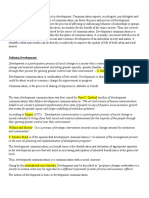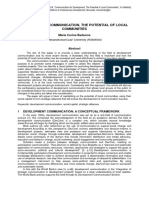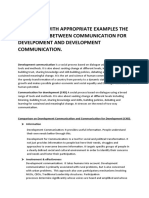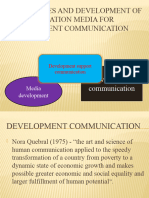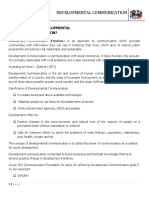LINKING DEVELOPMENT
AND COMMUNICATION
A Synergistic Approach
�LEARNING OBJECTIVES
By the end of this report, you will be able to:
1. Understand the fundamental concepts of development and communication;
2. Grasp the intricate link between development, communication, and policy goals;
3. Acknowledge the crucial role of communication in development initiatives; and
4. Develop strategic approaches to sustain development through effective communication.
2
� WHAT IS DEVELOPMENT COMMUNICATION?
DEVELOPMENT COMMUNICATION
Development involves Communication has to
gradual advancement do with the transfer of
and a series of information from one
changes that lead to person or group of
progress in the society. persons to another.
DEVELOPMENT COMMUNICATION refers
to using communication to facilitate
development in the society. Its primary
purposes include fulfilment of basic needs,
social transformation and development.
3
�WHAT IS THE PURPOSE OF DEVELOPMENT?
People generally seek improvement in their lives. They aspire to enhance their living
standards and overall quality of life. It is essential for individuals to have access to better
opportunities and to receive fair compensation for their work. There is a widespread
desire for positive change. Development should occur without harming natural resources
or the environment. Its impact should be beneficial, influencing populations, societies,
nations, communities, and ultimately individuals. Development leads to an increase in
living standards and involves transformations in both practices and thought processes.
�THREE MAJOR APPROACHES TO DEVELOPMENT
• Focuses on providing basic necessities and social
The Welfare Approach services to improve people’s lives.
• Emphasizes the protection and fulfillment of human
The Rights Approach rights as a fundamental aspect of development.
• Balances economic growth, social development, and
The Sustainability Approach environmental protection for long-term well-being.
5
�COMMUNICATION: THE BRIDGE BETWEEN POLICY AND DEVELOPMENT
• Communication is a dynamic process involving
The Process Of encoding a message by a sender, transmitting it
through a channel, decoding it by a receiver,
Communication providing feedback, and repeating the cycle,
influenced by various factors.
• Intrapersonal communication. Communication within
oneself. Inner dialogue.
Levels of Communication • Interpersonal communication. Direct conversation.
• Mass communication. Communication through media.
6
�COMMUNICATION: THE BRIDGE BETWEEN POLICY AND DEVELOPMENT
What Is Communication for Development?
‘Communication for development stresses the need to support two-way communication systems that enable dialogue and that allow communities
to speak out, express their aspirations and concerns and participate in the decisions that relate to their development’ (United Nations).
‘A social process based on dialogue using a broad range of tools and methods. It is also about seeking change at different levels including
listening, building 1Introduction 6 trust, sharing knowledge and skills, building policies, debating and learning for sustained and meaningful
change’ (World Congress on Communication for Development).
Put simply, Communication for Development (C4D) enables people, particularly the most disadvantaged in society, to participate in shaping
decisions that affect their lives.
Communication for Development contrasts sharply with how Communication is often understood within the broader development arena where it
is commonly associated with enhancing the public profile of organizations and advocating on specific program areas. (Source: From the
booklet, Communication for Development A Glimpse at UNDP’S Practice, pp. 5,6)
7
�COMMUNICATION: THE BRIDGE BETWEEN POLICY AND DEVELOPMENT
• Informing and Engaging. Effective communication
involves sharing information with the public and
actively seeking their input to ensure policies are
relevant and responsive.
• Mobilizing Support. By building strong
The Importance Of relationships with stakeholders and advocating for
Communication In Policy policies, communication can garner support and
Formulation resources for development initiatives.
• Monitoring and Evaluation. Through regular
communication and data collection, policymakers
can track progress, identify challenges, and make
necessary adjustments to improve policy
implementation.
8
�COMMUNICATION: THE BRIDGE BETWEEN POLICY AND DEVELOPMENT
COMMUNICATION: THE BRIDGE BETWEEN POLICY AND DEVELOPMENT DEVELOPMENT
• Stakeholders in communication policy include government
agencies, private companies, non-profit organizations, and the
general public, all of whom have an interest in how
Stakeholders in information is shared and regulated. Their involvement
Communication Policy ensures that diverse perspectives are considered, promoting
transparency, accountability, and inclusivity in policymaking.
This engagement is essential for creating fair communication
policies that protect individual rights.
9
�POLICY GOALS: THE ENGINE DRIVING DEVELOPMENT COMMUNICATION
Policy goals in development communication are the specific objectives that guide the design
and implementation of communication strategies to achieve broader development objectives.
These goals are often aligned with national development plans or international development
frameworks like the Sustainable Development Goals (SDGs).
The Sustainable Development Goals (SDGs) are a collection of 17 global goals established
by the United Nations in 2015 as part of the 2030 Agenda for Sustainable Development.
These goals aim to address a broad range of interconnected global challenges, including
poverty eradication, environmental sustainability, social equity, and economic growth, under
the guiding principle of "leaving no one behind."
10
�POLICY GOALS: THE ENGINE DRIVING DEVELOPMENT COMMUNICATION
1. No poverty
2. Zero hunger
3. Good Health and Well-being
4. Quality Education
5. Gender Equality
6. Clean Water and Sanitation
Sustainable 7. Affordable and Clean Energy
8. Decent Work and Economic Growth
Development 9. Industry, Innovation and Infrastructure
10. Reduced Inequality
Goals (DSGs): 11. Sustainable Cities and Communities
12. Responsible Consumption and
Production
13. Climate Action
14. Life Below Water
15. Life on Land
16. Peace, Justice and Strong Institutions
17. Partnerships for the Goals
11
�POLICY GOALS: THE ENGINE DRIVING DEVELOPMENT COMMUNICATION
12
�SOME COMMUNICATION STRATEGIES FOR SUSTAINABLE DEVELOPMENT
The process of bringing together all societal
and personal influences to raise awareness
Social Mobilization of and demand for development actions that
involves all the concerns actors
The process of creating programs and services,
Advocacy developing partnerships, and changing public policies,
laws, and practices to facilitate development
Behavior Change Strategies that enhance participants' motivation and adherence to
Strategies development actions
13
�SOME COMMUNICATION STRATEGIES FOR SUSTAINABLE DEVELOPMENT
A form of persuasion to internalized
Social Change Strategies development efforts. Application of
economic, political, and moral power and
institutions to make people change attitudes,
beliefs, behavior, or values
Information Dissemination & Focuses on collecting and distributing information to
Education educate people on development plan
An approach used to develop activities aimed at changing or maintaining
Social Marketing people's behavior for the benefit of individuals and society as a whole
14
�SOME COMMUNICATION STRATEGIES FOR SUSTAINABLE DEVELOPMENT
Involves the use of variety of communication
Communication for Social Change techniques to address inefficient systems,
processes, or reluctance to adopt or adapt to
developmental change or plan
Involvement of people in a community developmental
Community Participation projects or actions to solve their own problems
15
�SUMMARY
In summary, promoting sustainable development and accomplishing policy goals depend mainly on
effective communication. It facilitates crisis management, improves information flow, meaningfully
engages stakeholders, promotes education initiatives, aligns goals across sectors, openly tracks
progress, and pushes for essential policy changes. Prioritizing excellent communication will be
essential to successfully advancing sustainable development agendas as global issues get more
complicated.
16
�SHORT QUIZ
1. It involves gradual advancement and a series of changes that lead to progress in the
society.
2. It has to do with the transfer of information from one person or group of persons to
another.
3. Give at least one approach to development.
4. Give at least one importance of communication in policy formulation.
5. Give at least one communication strategies for sustainable development.
17
�THE END.
